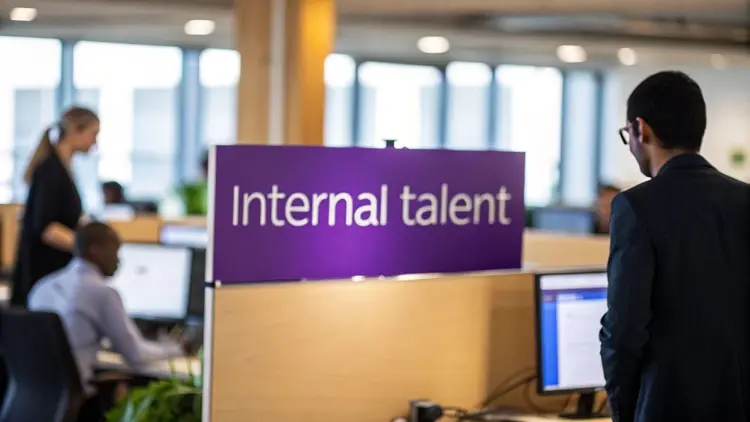Industry Trends
Top Recruiting Strategies for 2025: Stay Ahead in Hiring

Looking to Hire More Efficiently?
Finding and hiring the right people can be difficult. Effective recruitment strategies are key to securing top talent. This listicle outlines nine essential strategies to help UK businesses in healthcare, hospitality, retail, and SMEs attract and hire the best candidates in 2025 and beyond. Discover how to build talent pipelines, use social media and AI, enhance your employer branding, and incorporate diversity, equity, and inclusion (DEI) into your recruitment strategies. These concepts are essential for attracting, engaging, and securing the talent your business needs to prosper.
Listen to our podcast Here:
1. Employee Referral Programmes
Employee referral programmes are a powerful recruiting strategy where your current employees become ambassadors, actively seeking out qualified candidates within their networks. This method uses the power of warm introductions and trusted relationships to connect you with potential hires who are likely to be a strong cultural and professional fit for your organisation. By incentivising referrals, you tap into a pre-vetted talent pool, effectively simplifying your recruitment process and saving time and resources. This strategy is particularly effective for UK businesses across various sectors, including healthcare, hospitality, retail, and small to mid-sized enterprises.

The principle is simple: people tend to know others like themselves. If you have a strong, positive workplace culture, your employees will naturally gravitate towards individuals with similar values and work ethics. This organic filtering process leads to higher quality candidates who are more likely to integrate seamlessly into your team and remain long-term. Furthermore, referrals often come with an inherent understanding of your company's mission and values, shortening the onboarding process and speeding up their productivity.
Employee referral programmes should be a key part of any recruitment strategy due to their effectiveness. They consistently deliver higher quality candidates with a better cultural fit compared to traditional methods. The trust associated with a referral reduces the risk of a bad hire and increases the likelihood of a long-term, successful employment relationship.
A well-structured employee referral programme includes several features. These typically involve financial incentives, such as bonuses paid upon the successful hire of a referred candidate. Non-financial rewards like extra holiday days or gift vouchers can also be highly effective. A robust tracking and reward system is essential for transparency and efficient management of the programme. Integration with your existing HRIS systems ensures seamless data flow and minimises administrative overhead. Clear guidelines on eligible positions and referral criteria are crucial to avoid confusion and ensure fairness.
Tech giants like Google and Facebook have long championed the power of employee referrals, with Google attributing nearly 50% of their hires to their programme. Salesforce also offers generous referral bonuses, reportedly up to £5,500 for technical roles. Closer to home, numerous UK businesses, particularly in competitive sectors like hospitality and healthcare, are finding success with well-implemented referral schemes.
While the benefits are substantial, it's crucial to be aware of potential drawbacks. Over-reliance on referrals can inadvertently create a homogeneous workforce, limiting diversity and potentially leading to "groupthink." It’s important to implement safeguards against favouritism or bias, ensuring that all applicants, regardless of their referral status, are evaluated fairly. Regularly tracking diversity metrics within your referral programme is critical to maintaining an inclusive hiring process. Learn more about Employee Referral Programmes to explore strategies for maximising the benefits while mitigating the risks.
Here are some actionable tips for creating a successful employee referral programme in your organisation:
Set crystal-clear criteria: Define what constitutes a successful referral (e.g., the candidate completes the probationary period). This clarity eliminates ambiguity and sets clear expectations.
Provide regular updates: Keep referring employees informed about the status of their referrals. This shows respect for their efforts and encourages future participation.
Offer tiered rewards: Consider offering higher rewards for hard-to-fill roles or senior positions to incentivise referrals for critical vacancies.
Promote the programme: Actively promote your referral programme internally through regular communication and engaging activities.
Track diversity metrics: Monitor the diversity of your referrals and hires to identify any potential imbalances and address them proactively.
Employee referral programmes are a cost-effective and efficient recruiting strategy that can significantly impact your hiring success. By using the power of your existing workforce, you can access a pool of high-quality candidates who are more likely to thrive in your organisation. By carefully considering the pros and cons and implementing best practices, you can create a referral programme that strengthens your team and drives business growth.
2. Social Media Recruiting
Social media recruiting is a modern recruiting strategy that uses social media platforms to attract, engage, and recruit top talent. It involves showcasing your company culture, posting job opportunities, and building talent communities online, effectively turning social networks like LinkedIn, Twitter, Instagram, and even TikTok into powerful recruitment channels. This approach is particularly valuable for UK businesses in sectors like healthcare, hospitality, retail, and SMEs where competition for skilled workers is often fierce.

This recruiting strategy deserves its place on this list because it offers a direct line to both active and passive job seekers. It provides a cost-effective alternative to traditional job boards, allows authentic portrayal of your company culture, and facilitates real-time engagement with potential candidates. For example, if you're a care home looking for compassionate carers, you can use social media to showcase the rewarding aspects of the job and the supportive environment you offer. Similarly, a restaurant can showcase its vibrant team and exciting culinary creations to attract chefs and front-of-house staff.
Social media recruiting encompasses several key features. Building a multi-platform presence across networks like LinkedIn (for professional networking), Twitter (for company updates and industry news), Instagram (for visual storytelling), and even TikTok (for engaging younger demographics) is essential. This approach allows you to reach a diverse pool of candidates. Employer branding through content marketing is crucial, sharing compelling stories, employee testimonials, and insights into your company values to attract candidates who align with your organisation's mission. Direct candidate engagement and communication through comments, messages, and even live Q&A sessions fosters relationships and builds a strong employer brand. Finally, targeted advertising and job promotion capabilities on these platforms allow you to reach specific demographics and skill sets, ensuring your job postings reach the right audience.
The advantages of social media recruiting are numerous. It provides access to passive candidates who might not be actively searching on job boards but could be enticed by an engaging company profile or job advertisement. This is particularly relevant in the current UK job market where skills shortages are prevalent. Compared to traditional job boards, social media recruiting offers a more cost-effective solution, especially for smaller businesses. It also allows you to showcase your company culture authentically, offering potential candidates a glimpse into what it's like to work for your organisation. This transparency builds trust and attracts candidates who are a good cultural fit. Finally, social media facilitates real-time engagement and relationship building with potential hires, enabling you to answer questions, address concerns, and foster a sense of community.
However, social media recruiting also presents some challenges. Creating and managing engaging content across multiple platforms can be time-intensive, requiring dedicated resources. Measuring the return on investment (ROI) and conversion rates can be difficult, requiring careful tracking and analysis. There's also a risk of negative employer brand exposure if negative comments or reviews are not handled effectively. Finally, platform algorithm changes can affect the reach of your content, requiring ongoing adaptation and optimisation.
Successful implementations of social media recruiting abound. IBM uses LinkedIn to share employee stories and attract tech talent, showcasing the innovation and career development opportunities they offer. Starbucks leverages Instagram to showcase their workplace culture and community involvement, appealing to a younger demographic. Even McDonald's has used Snapchat filters for recruitment campaigns, targeting a specific age group with creative and engaging content.
To maximise the effectiveness of social media recruiting, consider these actionable tips. Develop platform-specific content strategies, tailoring your message and format to each platform's unique audience. Use employee advocacy to amplify your reach, encouraging your employees to share company content and job postings with their own networks. Respond promptly to comments and messages, demonstrating your engagement and responsiveness to potential candidates. Finally, track engagement metrics like likes, shares, and comments and adjust your content accordingly to optimise your strategy.
Learn more about Social Media Recruiting This resource offers further insights and best practices for incorporating social media into your recruiting strategies. By strategically using social media, UK businesses can effectively attract, engage, and recruit the talent they need to thrive in today's competitive market.
3. Talent Communities and Pipelines
In today's competitive hiring landscape, simply reacting to open positions isn't enough. Forward-thinking organisations are adopting proactive recruiting strategies, and one of the most effective is building talent communities and pipelines. This involves nurturing relationships with potential candidates before specific job openings arise, creating a readily available pool of pre-qualified, engaged individuals for future opportunities. Think of it as cultivating a talent garden, where you're consistently tending to promising prospects so they're ready to bloom when the time is right. This approach is particularly beneficial for UK businesses facing skills shortages and high competition for top talent.

Talent communities operate much like a Customer Relationship Management (CRM) system, but for candidates. They allow you to segment potential hires based on skills, experience, and interests, enabling targeted communication and relationship building. This might involve regular newsletters with industry updates, exclusive webinars and networking events, or even access to skills development and career guidance resources. By providing value beyond just job postings, you position your organisation as an employer of choice and stay top-of-mind for potential candidates.
The benefits of this proactive approach are numerous. When a position opens, you can tap into your pre-existing talent pool, drastically reducing time-to-hire and often leading to higher quality candidates who are already familiar with your organisation's values and culture. This translates to a significantly improved candidate experience, boosting your employer brand and making you more attractive to top talent. For growing SMEs and larger organisations, well-managed talent pipelines are invaluable for succession planning and ensuring business continuity.
Examples of successful talent community implementation include Oracle's talent network, which boasts relationships with over 2 million professionals, and Microsoft's talent community, which offers valuable career development resources. Even Johnson & Johnson leverages early career programmes to cultivate future talent pipelines. These examples showcase the power of this strategy across various industries and scales.
While powerful, building talent communities does require a long-term investment. Maintaining engagement without immediate opportunities can be challenging, and robust tracking and management systems are crucial for success. Over-promising without delivering can also lead to unrealistic candidate expectations, so careful management is key.
When and Why to Use Talent Communities and Pipelines:
This strategy is particularly beneficial for:
Healthcare & Care Organisations: Facing persistent staffing shortages, building talent pipelines for nurses, carers, and other healthcare professionals is crucial for maintaining service levels.
Hospitality & Retail Businesses: High turnover rates in these sectors necessitate a constant influx of new talent. Talent communities can streamline recruitment for roles like chefs, waiters, and retail assistants.
SMEs with In-house HR Teams: Even smaller teams can benefit from building talent pools for frequently filled roles, reducing recruitment costs and improving hiring speed.
Actionable Tips for Building Your Talent Community:
Segmentation is Key: Divide your community into smaller groups based on skills, experience, and interests. This allows for more personalised communication and a higher level of engagement.
Content is King: Provide valuable content beyond just job postings. Think industry insights, career advice, and company updates.
Automate and Personalise: Use automation tools to send personalised emails and updates, ensuring consistent communication without overwhelming your team.
Regularly Assess and Refresh: Continuously monitor your community engagement strategies and make adjustments as needed. Track metrics like open rates, click-through rates, and application rates to measure effectiveness.
Manage Expectations: Be transparent with candidates about the purpose of the community and the timeline for potential opportunities.
Talent communities and pipelines, pioneered by large enterprises like GE and IBM and facilitated by platforms like SmashFly (now part of Symphony Talent), are no longer a luxury but a necessity in today’s dynamic talent market. By embracing this proactive strategy, UK organisations can build a strong foundation for future growth and success.
4. Recruitment Process Outsourcing (RPO)
Recruitment Process Outsourcing (RPO) is a strategic recruiting strategy where a company transfers all or part of its recruitment processes to an external provider. This provider becomes a strategic partner, managing tasks such as sourcing, screening, interviewing, and onboarding candidates. RPO differs from using temporary staffing agencies as it focuses on building long-term talent pipelines and improving the overall recruitment process. It allows companies to focus on their core business activities while benefiting from the expertise, technology, and scalability of a dedicated recruitment team. This makes RPO a valuable recruiting strategy, especially for companies facing rapid growth, high-volume hiring needs, or a lack of internal recruitment resources.

RPO providers offer a range of services, from full-service recruitment management, which covers the entire hiring lifecycle, to project-based solutions focusing on specific needs. They use advanced recruiting technology and tools, including applicant tracking systems (ATS), candidate relationship management (CRM) software, and AI-powered sourcing platforms. This technology enables them to identify and engage top talent more efficiently. Importantly, RPO offers scalable solutions, allowing businesses to adapt to fluctuating hiring demands. Whether you’re a small hospitality business in Edinburgh experiencing seasonal spikes or a growing healthcare organisation in London with ongoing recruitment needs, RPO can adapt to your requirements. Dedicated recruitment specialists and account managers within the RPO provider ensure personalised service and consistent communication.
Several well-known companies have successfully implemented RPO. Microsoft, for example, partners with multiple RPO providers to manage its extensive global hiring needs. Procter & Gamble uses RPO for high-volume recruitment, ensuring a consistent flow of qualified candidates. Closer to home, many UK-based retailers and hospitality businesses have partnered with RPO providers to handle seasonal recruitment surges effectively.
Pros of RPO:
Access to specialised recruiting expertise and technology: RPO providers bring deep recruitment knowledge and access to advanced tools, often surpassing the capabilities of in-house teams, particularly in SMEs.
Cost reduction and improved hiring efficiency: Streamlined processes, reduced time-to-hire, and lower administrative burdens contribute to significant cost savings.
Scalability for fluctuating hiring needs: RPO allows businesses to quickly scale their recruitment efforts up or down based on demand, crucial for sectors like retail and hospitality.
Enhanced candidate experience and employer branding: Dedicated specialists within the RPO provider can create positive candidate experiences and strengthen your employer brand.
Cons of RPO:
Loss of direct control over recruitment processes: Sharing control requires trust and clear communication with the RPO provider.
Potential disconnect between RPO provider and company culture: It’s essential to choose a provider who understands your values and can represent your culture effectively to candidates.
Higher costs for small-scale hiring needs: For very limited hiring, the cost of RPO might outweigh the benefits. A cost-benefit analysis is crucial.
Dependency on external provider performance: Your recruitment success becomes reliant on the RPO provider’s effectiveness, highlighting the importance of choosing a reputable partner.
Tips for successful RPO implementation:
Clearly define Service Level Agreements (SLAs) and performance metrics: Establish clear expectations from the outset regarding time-to-hire, quality of hire, and other key metrics.
Maintain strong communication and cultural alignment: Regular communication ensures that the RPO provider stays aligned with your company’s goals and values.
Start with pilot programmes before full implementation: Test the relationship and refine processes with a smaller project before committing to a full-scale RPO partnership.
Regularly review and optimise the partnership: Continuously evaluate the performance of the RPO provider and make adjustments as needed to ensure optimal results.
RPO is a valuable recruiting strategy for UK businesses seeking to improve their hiring processes and gain a competitive edge. By using the expertise and resources of an RPO provider, organisations can build stronger teams, reduce costs, and focus on their core business objectives. This is particularly relevant for healthcare and care organisations facing ongoing staffing challenges, as well as for hospitality and retail businesses needing to manage seasonal peaks in hiring. For in-house HR teams in SMEs, RPO can offer crucial support and free up valuable time to focus on strategic HR initiatives. However, careful consideration of the pros and cons, alongside meticulous planning and communication, are vital for successful RPO implementation.
5. Campus Recruiting and University Partnerships
Campus recruiting and university partnerships represent a valuable recruiting strategy, particularly beneficial for organisations seeking emerging talent with fresh perspectives and the latest skills. This strategy involves systematically engaging with educational institutions – universities, colleges, and even vocational schools – to identify, attract, and hire students and recent graduates. This engagement can take numerous forms, including internships, co-op programmes, career fairs, campus events, academic partnerships, and curriculum collaboration. It is a proactive approach that focuses on building relationships and a talent pipeline for future hiring needs, proving particularly effective for healthcare organisations, hospitality businesses, and SMEs looking to inject new energy and skills into their workforce.
For UK businesses, campus recruitment provides access to a diverse pool of candidates graduating from renowned universities. This is especially crucial for organisations seeking specific skill sets that are in high demand, like data analysis, digital marketing, or specialised care in the healthcare sector. By partnering with universities offering relevant programmes, organisations can tailor their recruitment efforts and effectively target the graduates who possess the skills they require.
This recruiting strategy is more than just attending a career fair; it’s about building a sustained presence within the academic community. It's about creating meaningful relationships with career services departments, participating in campus events, and even collaborating with universities on curriculum development. This allows businesses to establish themselves as employers of choice and gain early access to top-tier talent before they enter the competitive job market.
How Campus Recruiting Works:
Campus recruiting usually follows a structured process:
Identifying Target Institutions: Organisations identify universities and programmes aligning with their talent needs. For a healthcare organisation, this might involve partnering with universities renowned for their nursing or physiotherapy programmes. A retail business might focus on institutions with strong retail management or marketing degrees.
Developing Relationships: Building strong relationships with university career services, faculty, and student organisations is crucial. This involves regular communication, participation in university events, and sponsoring relevant student clubs.
Creating Engaging Internship Programmes: Structured internship and co-op programmes are a cornerstone of campus recruiting. These provide students with valuable practical experience, allowing businesses to evaluate potential employees and build a talent pipeline. Offering meaningful internship experiences that translate into full-time employment opportunities is essential.
Participating in Career Fairs and Campus Events: Career fairs provide a platform to connect directly with a large number of students and recent graduates. Hosting presentations, workshops, and networking events on campus can also effectively promote your organisation and attract talent.
Early Identification and Development: Campus recruiting allows organisations to identify high-potential individuals early in their academic careers. Through internships and mentoring programmes, businesses can nurture these individuals and prepare them for future roles within the organisation.
Examples of Successful Implementation:
Numerous organisations have successfully implemented campus recruitment strategies. Goldman Sachs has a long-standing reputation for its global campus recruiting programme, targeting top universities worldwide. Similarly, Accenture hires thousands of graduates annually through its robust campus recruitment efforts. Closer to home, many UK-based retailers like Tesco and Sainsbury's have successful graduate recruitment programmes, demonstrating the effectiveness of this strategy across various sectors.
Pros and Cons of Campus Recruiting:
Pros:
Access to a pool of emerging talent with the latest skills.
Opportunity to shape and develop candidates according to your organisation’s needs.
Strong ROI through intern-to-hire conversions, saving recruitment costs in the long run.
Enhanced employer brand among young professionals, building a positive reputation for the future.
Cons:
High investment in time and resources, requiring dedicated staff and budget.
Competition with other employers for top talent, demanding a compelling employer value proposition.
Seasonal and cyclical hiring patterns, primarily focused on graduate intake periods.
Need for extensive onboarding and training programmes to prepare graduates for the workplace.
Tips for Effective Campus Recruiting:
Build authentic relationships: Cultivate genuine connections with career services, faculty, and student organisations.
Offer meaningful internship experiences: Provide interns with real-world projects and mentorship opportunities.
Engage with student organisations and clubs: Sponsor events and connect with students based on their interests.
Track long-term success metrics: Monitor the performance and retention rates of campus hires to evaluate programme effectiveness.
Campus recruiting and university partnerships deserve a prominent place in any comprehensive recruiting strategy. It provides a proactive and structured approach to identifying, attracting, and developing future talent. While it requires investment and commitment, the potential rewards – access to a pipeline of skilled and motivated graduates – can significantly contribute to an organisation’s long-term success. By actively engaging with universities and offering valuable opportunities to students, organisations can build a strong talent pipeline and secure a competitive advantage in today's rapidly evolving job market.
6. AI-Powered Recruiting and Automation
In today's competitive hiring landscape, attracting and securing top talent requires efficient and strategic recruiting strategies. AI-powered recruiting and automation have emerged as a significant development, offering a data-driven approach that streamlines processes and enhances decision-making. This strategy utilises artificial intelligence (AI) and machine learning to automate various aspects of recruitment, from initial candidate screening to scheduling interviews, ultimately leading to a faster and more effective hiring process. This is particularly relevant for UK businesses, including healthcare organisations, hospitality, retail, and SMEs, where efficient recruitment is crucial.
AI-powered recruiting tools work by analysing large datasets of candidate information, job descriptions, and performance data to identify patterns and predict successful hires. These tools employ sophisticated algorithms to automatically screen CVs, rank candidates based on their suitability, and even conduct initial candidate interactions through AI-powered chatbots. This automation frees up HR professionals from time-consuming administrative tasks, allowing them to focus on more strategic aspects of recruitment, such as building relationships with candidates and assessing cultural fit.
Key Features and Benefits:
Automated CV Screening and Candidate Ranking: AI algorithms can swiftly sift through hundreds of CVs, identifying candidates who closely match the required skills and experience outlined in the job description. This significantly reduces the time spent manually reviewing applications and ensures that promising candidates don’t get overlooked.
AI-Powered Chatbots for Initial Candidate Interactions: Chatbots can engage with candidates 24/7, answering frequently asked questions, scheduling interviews, and providing updates on the application process. This enhances the candidate experience and ensures consistent communication, even outside of business hours.
Predictive Analytics for Hiring Success: AI can analyse historical hiring data to predict the likelihood of a candidate's success in a particular role. This data-driven insight helps recruiters make more informed hiring decisions and reduces the risk of costly mis-hires.
Machine Learning Algorithms for Job-Candidate Matching: AI algorithms can identify subtle connections between a candidate's skills and experience and the requirements of a job, even if the candidate hasn't explicitly listed those keywords in their CV. This ensures a more accurate matching process.
Real-world Examples:
Several large organisations have successfully implemented AI-powered recruiting strategies. Unilever uses AI for initial candidate screening, significantly reducing their time-to-hire. Hilton employs chatbots for high-volume hiring, streamlining their recruitment process and improving candidate engagement. L'Oréal uses gamified AI assessments to identify candidates with the desired cognitive abilities and personality traits. These examples demonstrate the tangible benefits of incorporating AI into recruitment processes.
Pros and Cons:
While AI-powered recruiting offers numerous advantages, it’s important to be aware of the potential drawbacks:
Pros:
Significant reduction in time-to-hire
Improved candidate matching accuracy
24/7 candidate engagement capabilities
Data-driven insights for recruitment optimisation
Cons:
Risk of algorithmic bias in screening
High initial implementation costs
Potential loss of the "human touch" in recruitment
Need for ongoing system training and maintenance
Tips for Successful Implementation:
Regularly Audit AI Systems for Bias and Accuracy: Ensure that the AI algorithms used are fair and unbiased. Regular audits can help identify and mitigate any potential biases that may creep into the system.
Maintain Human Oversight in Final Hiring Decisions: While AI can automate many aspects of recruitment, human judgement is still crucial, particularly in the final stages of the hiring process.
Start with Pilot Programmes in Specific Roles or Departments: Begin by implementing AI-powered recruiting in a limited capacity, focusing on specific roles or departments. This allows for a controlled rollout and provides valuable insights for scaling up the implementation.
Ensure Compliance with Employment Law and Regulations: It's crucial to ensure that AI-powered recruiting practices comply with all relevant UK employment laws and regulations, including data privacy and anti-discrimination laws.
For a deeper dive into the available tools and software, you can learn more about AI-Powered Recruiting and Automation.
AI-powered recruiting and automation is no longer a futuristic concept; it's a present-day reality that is changing the way organisations attract and hire talent. By embracing these recruiting strategies, businesses in the UK, especially those in healthcare, hospitality, retail, and SMEs, can gain a competitive edge in the talent market. This approach enables faster hiring, improved candidate quality, and a more efficient use of HR resources. By carefully considering the pros and cons and following the recommended implementation tips, organisations can use AI to build high-performing teams and achieve their business objectives.
7. Diversity, Equity, and Inclusion (DEI) Recruiting
Diversity, Equity, and Inclusion (DEI) recruiting is more than just a trend; it's a crucial recruiting strategy for building strong, innovative, and representative workforces. It's a systematic approach to attracting, hiring, and retaining diverse talent, encompassing everything from removing bias from your recruitment processes to creating truly inclusive workplace environments. In today's competitive market, particularly in sectors like healthcare, hospitality, retail, and within small to mid-sized enterprises, DEI is essential for attracting top talent and reflecting the diverse communities these organisations serve.
This strategy moves beyond simply filling quotas. It's about fostering a culture where individuals from all backgrounds feel valued, respected, and empowered to contribute their unique perspectives. This includes individuals from different ethnicities, genders, sexual orientations, religions, socio-economic backgrounds, abilities, and ages. Implementing DEI initiatives is not just ethically sound; it’s a vital business imperative.
DEI recruiting involves several key features. First, it requires crafting bias-free job descriptions and requirements. This means using inclusive language, avoiding gender-coded words, and focusing on skills and experience rather than specific qualifications that might disproportionately exclude certain groups. Second, diverse candidate sourcing strategies are essential. This could involve partnering with diverse professional organisations, attending specialist job fairs, and using online platforms that cater to underrepresented groups. Third, inclusive interview processes are paramount. This includes using diverse hiring panels to mitigate unconscious bias and structuring interviews with standardised questions to ensure fairness and consistency.
The benefits of DEI recruiting are numerous. It provides access to broader talent pools, leading to a more diverse range of skills, experiences, and perspectives within your organisation. This, in turn, fuels innovation, improves business performance, and enhances problem-solving capabilities. Moreover, a commitment to DEI enhances your employer brand and reputation, attracting socially conscious candidates and bolstering customer loyalty, especially as your workforce better reflects your customer demographics. In the UK specifically, where diversity is a prominent societal value, implementing DEI can significantly strengthen an organisation's standing within the community.
However, implementing DEI recruiting is not without its challenges. There can be potential resistance to change from existing teams, particularly if they are not fully on board with the rationale and benefits of DEI. Measuring and tracking DEI progress can also be complex, requiring the establishment of clear metrics and regular monitoring. There's also a risk of tokenism if DEI initiatives are not implemented authentically, which can be detrimental to both the organisation's reputation and the individuals involved. Finally, it's important to understand that creating a truly inclusive culture takes time and ongoing effort. Significant cultural changes don't happen overnight.
Numerous examples demonstrate the positive impact of DEI recruiting. Salesforce, for instance, achieved pay equity across its workforce, showcasing a commitment to fair compensation regardless of gender or ethnicity. Intel invested $300 million in diversity initiatives, demonstrating the scale of investment some organisations are making in this area. Closer to home, Airbnb redesigned its entire hiring process with inclusion in mind, a move championed by their Chief Diversity Officer, Ertharin Cousin. These examples, alongside the work of companies like Patagonia and Ben & Jerry’s, and various DEI consulting firms and advocacy organisations, highlight the increasing focus on DEI within the business world.
For HR managers in UK businesses, particularly those in healthcare, hospitality, and retail, incorporating DEI into recruiting strategies should be a priority. To get started, set specific, measurable diversity goals and timelines. Train hiring managers on unconscious bias to help them identify and mitigate their own biases during the recruitment process. Use structured interviews and standardised evaluation criteria to ensure fairness and consistency. Partner with diverse professional organisations and universities to access wider talent pools. Learn more about Diversity, Equity, and Inclusion (DEI) Recruiting
Ultimately, DEI recruiting is not just a box to be ticked; it’s an ongoing journey of continuous improvement. By embracing DEI as a core recruiting strategy, organisations can unlock the immense potential of a diverse workforce, fostering a culture of inclusivity, innovation, and success. This approach deserves its place amongst the top recruiting strategies because it addresses a fundamental need for businesses to adapt to a changing world, access wider talent pools, and create more representative and equitable workplaces.
8. Passive Candidate Sourcing
Passive candidate sourcing is a proactive recruiting strategy that focuses on identifying and engaging high-performing professionals who aren't actively looking for new jobs. Unlike traditional recruiting, which relies on job postings and applications, passive sourcing involves directly reaching out to individuals who are currently employed and may not be considering a career move. This approach allows businesses, especially in competitive sectors like healthcare, hospitality, retail, and SMEs, to tap into a hidden talent pool and gain a significant advantage in talent acquisition. This strategy is a vital component of modern recruiting strategies, particularly for filling specialised roles or attracting top-tier talent.
Passive candidate sourcing involves researching and identifying individuals with the desired skills and experience, then building relationships and presenting them with compelling opportunities. This often requires more effort and finesse than simply posting a job ad, but the potential rewards are significant. Accessing this “hidden” talent pool offers several key benefits. Firstly, it broadens the scope of potential candidates beyond those actively searching, providing a wider selection of highly skilled individuals. Secondly, passive candidates often possess established track records and valuable experience within their current roles. Finally, engaging passive talent offers a competitive edge, particularly in a tight labour market, as these individuals are less likely to be pursued by numerous other companies.
How Passive Candidate Sourcing Works:
The process typically involves several key steps:
Market Mapping and Competitor Analysis: Identifying key players in your industry, analysing their workforce, and pinpointing individuals with desirable skills and experience.
Advanced Boolean Search Techniques: Using complex search strings on platforms like LinkedIn to filter and identify potential candidates based on specific criteria (e.g., skills, location, job titles).
Direct Outreach via LinkedIn and Email: Crafting personalised messages that resonate with individual candidates, highlighting the unique value proposition of the opportunity and your organisation.
Relationship Building over Extended Periods: Nurturing relationships with potential candidates over time, even if they're not immediately interested in a new role, to establish trust and credibility.
Examples of Successful Implementation:
Tech Giants: Companies like Apple, Tesla, Google, and Amazon heavily rely on passive sourcing to secure top engineering, design, and product management talent. They often use dedicated sourcing teams and sophisticated tools to identify and engage potential candidates.
Executive Search Firms: These firms routinely utilise passive sourcing to fill C-level and other senior executive positions, using their extensive networks and industry expertise.
Healthcare Organisations: In the UK's competitive healthcare market, passive sourcing can be particularly effective in recruiting specialised medical professionals, nurses, and administrators who are not actively seeking new positions. This is especially valuable for filling niche roles or staffing hard-to-fill positions in rural areas.
Hospitality & Retail: Restaurants and retailers can use passive sourcing to identify experienced managers, chefs, and retail specialists who may be open to new opportunities but not actively searching. This can be especially valuable for high-turnover positions.
Actionable Tips for Passive Candidate Sourcing:
Personalise Your Outreach: Tailor your messages to each individual, demonstrating that you’ve researched their background and understand their skills and experience. Avoid generic templates.
Highlight the Value Proposition: Clearly articulate what makes your opportunity unique and appealing, focusing on career growth, company culture, and other factors that resonate with passive candidates.
Build Relationships Before Presenting Opportunities: Don’t immediately jump into a sales pitch. Engage in genuine conversation, share valuable industry insights, and establish a connection before discussing specific roles.
Leverage Employee Networks: Encourage your existing employees to refer qualified individuals from their networks. Warm introductions can be significantly more effective than cold outreach.
Use Multiple Touchpoints and Communication Channels: Don’t rely solely on email. Use LinkedIn InMail, professional networking events, and even phone calls to connect with potential candidates.
Pros and Cons of Passive Candidate Sourcing:
Pros:
Access to top talent unavailable through traditional job postings.
Higher quality candidates with proven track records.
Competitive advantage in talent acquisition.
Reduced competition from other employers.
Cons:
Time-intensive research and outreach process.
Lower response and conversion rates.
Requires skilled sourcers and recruiters.
Potential for higher salary expectations.
Passive candidate sourcing requires a strategic approach, dedicated resources, and skilled recruiters. However, the potential benefits, especially for UK businesses in competitive industries, make it a worthwhile investment. By proactively identifying and engaging passive candidates, you can build a strong talent pipeline and secure the best talent for your organisation.
9. Employer Branding and Content Marketing: Attract Top Talent Organically
In today’s competitive hiring landscape, simply posting job ads is no longer enough. Attracting the best talent requires a proactive, engaging approach, and that's where employer branding and content marketing come in. This recruiting strategy focuses on building a compelling employer value proposition (EVP) and showcasing it through strategic content creation, storytelling, and brand building to attract top talent organically. For UK healthcare providers, hospitality businesses, retailers, and SMEs, building a strong employer brand is crucial for attracting and retaining skilled staff in a challenging market.
Employer branding and content marketing work by showcasing what makes your organisation a great place to work. It goes beyond simply listing benefits and perks; it’s about communicating your company culture, values, and mission in a way that resonates with potential candidates. This approach shifts the focus from simply filling open positions to building long-term relationships with talent, turning your organisation into an employer of choice. Instead of chasing candidates, you create a magnet that draws them to you. This is particularly vital for sectors like healthcare and hospitality, where employee retention is a significant challenge.
A robust employer branding and content marketing strategy involves several key features:
Employee Story and Testimonial Content: Real stories from current employees offer authentic insights into the employee experience. These testimonials humanise your brand and provide potential candidates with a glimpse into what it's like to work for your organisation.
Behind-the-Scenes Workplace Culture Showcases: Offer potential candidates a look behind the curtain. Showcasing your workplace culture through videos, photos, and blog posts can highlight the day-to-day experience, team dynamics, and overall atmosphere. This is especially relevant for retail and hospitality businesses where the work environment is a key factor for potential employees.
Thought Leadership and Industry Expertise Content: Positioning your organisation as a thought leader in your industry helps attract talent that values professional development and innovation. This can involve publishing articles, hosting webinars, or participating in industry events. For healthcare organisations, sharing research or best practices can attract top medical professionals.
Multi-Channel Brand Presence and Consistency: Maintaining a consistent brand message across various platforms, including your website, social media channels, and job boards, reinforces your employer brand and reaches a wider audience.
The benefits of this approach are numerous:
Attracts Candidates Who Align with Company Values: By showcasing your company culture and values, you attract candidates who are not just skilled, but also a good fit for your organisation. This can significantly improve employee retention and reduce recruitment costs in the long run.
Reduces Recruitment Costs through Organic Attraction: A strong employer brand attracts candidates organically, reducing reliance on expensive job boards and recruitment agencies.
Improves Employee Retention and Engagement: When employees feel connected to your brand and values, they are more likely to be engaged and stay with the company longer.
Creates Sustainable Competitive Advantage: In a tight labour market, a strong employer brand can differentiate you from competitors and give you an edge in attracting top talent.
However, there are also some potential downsides:
Long-Term Investment with Delayed Results: Building a strong employer brand takes time and consistent effort. You won't see results overnight.
Requires Consistent Content Creation and Management: Maintaining a consistent brand presence requires ongoing content creation and management, which can be resource-intensive.
Difficulty Measuring Direct Recruitment Impact: While the long-term benefits are clear, it can be challenging to directly measure the impact of employer branding on recruitment outcomes.
Risk of Brand Damage if Not Authentic: If your employer brand doesn't accurately reflect the reality of working for your organisation, it can damage your reputation and make it harder to attract talent.
Companies like HubSpot, Patagonia, and Netflix have demonstrated the power of employer branding. HubSpot's culture blog attracts millions of professionals, while Patagonia's environmental mission draws purpose-driven talent. Netflix's culture deck, which popularised this recruiting strategy, revolutionised employer branding. Learn more about Employer Branding and Content Marketing to understand the nuances of crafting a compelling narrative.
To successfully implement employer branding and content marketing as a recruiting strategy, consider these tips:
Ensure Authenticity: Your employer brand must accurately reflect your company culture and values. Don’t over-promise and under-deliver.
Use Employee-Generated Content: Encourage your employees to share their experiences. Employee-generated content is highly credible and engaging.
Measure Brand Awareness and Sentiment: Regularly track your brand awareness and sentiment among potential candidates to gauge the effectiveness of your efforts.
Align Employer Brand with Overall Company Brand: Ensure your employer brand aligns with your overall company brand and messaging.
By embracing employer branding and content marketing, your UK organisation, whether in healthcare, hospitality, retail, or another sector, can transform its recruitment process, attracting top talent who are not just looking for a job, but a place where they can thrive. This proactive approach sets the stage for a more engaged workforce, reduced turnover, and a sustainable competitive advantage in the challenging UK hiring market.
Recruiting Strategies Comparison Matrix
| Strategy | Implementation Complexity 🔄 | Resource Requirements ⚡ | Expected Outcomes 📊 | Ideal Use Cases 💡 | Key Advantages ⭐ |
|---|---|---|---|---|---|
| Employee Referral Programmes | Medium - requires system integration and tracking | Moderate - incentives and HRIS integration | Faster hires, better cultural fit, cost savings | Companies with existing engaged workforce | High quality candidates, lower cost per hire |
| Social Media Recruiting | High - content creation and multi-platform management | Moderate to High - ongoing content and ads | Access to passive candidates, real-time engagement | Brands seeking wide reach and employer branding efforts | Cost-effective, authentic culture showcase |
| Talent Communities and Pipelines | High - long-term engagement and management needed | High - CRM systems, events, content | Reduced time-to-hire, higher candidate engagement | Large enterprises focusing on workforce planning | Better candidate quality, improved brand |
| Recruitment Process Outsourcing (RPO) | Medium to High - coordination with external partner | High - outsourcing fees and management | Scalable hiring, efficiency improvements | Companies with fluctuating or large-scale hiring needs | Access to expertise, technology, scalability |
| Campus Recruiting and Univ. Partnerships | Medium - ongoing institution relations and events | High - time and event participation | Access to emerging talent, strong intern pipeline | Firms targeting entry-level and emerging professionals | Fresh skills, strong employer brand at universities |
| AI-Powered Recruiting & Automation | High - technology setup and ongoing maintenance | High - software investment and training | Faster hiring, improved matching, data insights | Organisations aiming to optimise recruitment efficiency | Significant time reduction, 24/7 candidate engagement |
| Diversity, Equity & Inclusion Recruiting | Medium to High - systemic process and training | Moderate to High - training, tools, partnerships | Broader talent pools, innovation boost | Companies prioritising inclusive hiring and culture | Enhanced brand, better business outcomes |
| Passive Candidate Sourcing | High - skilled sourcing and personalised outreach | Moderate - recruiter expertise and tools | Access to top talent not actively looking | Roles requiring niche or senior talent | Competitive advantage, higher quality hires |
| Employer Branding & Content Marketing | High - continuous content and storytelling effort | Moderate to High - content creation and promotion | Sustainable talent attraction, better retention | Organisations focusing on long-term talent attraction | Organic attraction, stronger employee engagement |
Elevate Your Recruiting with SeeMeHired
In today's competitive UK market, implementing robust recruiting strategies is no longer a luxury, but a necessity for healthcare providers, hospitality businesses, retailers, and SMEs alike. This article explored nine key strategies, from using employee referrals and social media to embracing AI and prioritising DEI, that can significantly impact your ability to attract and secure top-tier talent. Mastering these approaches is crucial for building a strong, diverse workforce and achieving your organisational goals. By focusing on building talent pipelines, proactively sourcing candidates, and nurturing a positive employer brand, you can future-proof your recruitment process and ensure a consistent flow of qualified applicants.
These diverse recruiting strategies, while highly effective, can be challenging to manage effectively. Disparate systems and manual processes can hinder your progress and lead to a fragmented candidate experience. This is where SeeMeHired comes in. As an all-in-one Applicant Tracking System (ATS), SeeMeHired simplifies your recruiting workflow by centralising communication, automating tasks, and providing AI-powered candidate matching, allowing you to implement these winning strategies efficiently. In the dynamic landscape of 2025 and beyond, SeeMeHired empowers you to hire more efficiently, not harder.
Ready to optimise your recruiting strategies and transform your hiring process? Request a demo at SeeMeHired today and discover how our platform can help your UK organisation attract, engage, and secure the best talent.





























